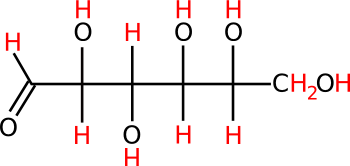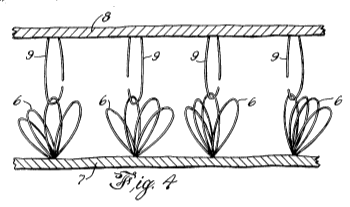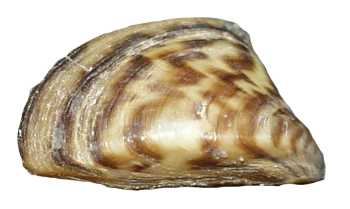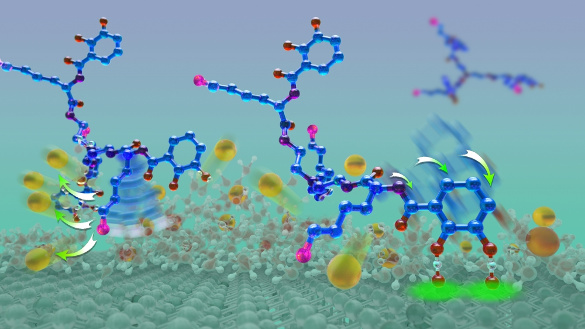Wet Adhesion
October 1, 2015
Many
families have the
tradition of having special
meals on
weekends when they're not rushed to exit the
house for
work and
school. My family always enjoyed having
pancakes on
Sunday. The only thing I hate about a pancake
breakfast is the
sticky syrup bottle. Perhaps I'm not alone in my dislike of having sticky
fingers and wanting to wash them as quickly as possible.
Sticky fingers are one example of
adhesion. Sticky fingers arise from a
chemical mechanism; namely,
hydrogen bonding.
Hydrogen atoms, while
bonded to
molecules, can still bond lightly to each other. That's what gives liquid
water its
cohesion.
Syrup is a solution of
monosaccharide sugar molecules in water, and these monosaccharide molecules have a lot of hydrogen atoms available for bonding (see figure). The stickiness arises from the combined bonding of the molecules to themselves and to your fingers.

Quite a few hydrogens for bonding.
D-glucose (Dextrose).
(Created using Inkscape.)
Along with hydrogen bonding, there are two simple,
mechanical forms of adhesion. The simplest case is the
suction cup that holds my
GPS receiver onto the
automobile windshield. There are no chemical
forces at work there, just the
pressure of the
air outside the cup pushing against the lack of air inside.
A novel form of mechanical adhesion is found in
Velcro™. I wrote about Velcro™ in an
earlier article (Insect Velcro, April 22, 2013). As can be seen from the figure from the Velcro™
patent, below, the principle of operation is having a myriad number of
hooks linking with eyelets.

Figure four of US Patent No. 3,009,235, 'Separable Fastening Device,' by George de Mestral, November 21, 1961.
(Via Google Patents.)[1]
Another type of adhesion arises from the
electrostatic attraction between
surfaces. A common example is the attraction of a
rubber balloon to objects after rubbing on some
fabrics. This fascinated me when I was a
child. That, and
magnetism, may have been the reasons that I became interested in
physics. A form of chemical adhesion different from hydrogen bonding involves a
chemical reaction between two surfaces. An example of this known to every
mechanic is the bond between a rusted
bolt and
nut.
A most interesting type of adhesion is
cold welding. Clean and atomically-flat surfaces will bond together when placed in contact in a
vacuum. As
Richard Feynman explained for
copper surfaces in his
Feynman Lectures (Vol. I, Chap. 12-3,
Molecular forces),
"The reason for this unexpected behavior is that when the atoms in contact are all of the same kind, there is no way for the atoms to 'know' that they are in different pieces of copper."[2]
This type of adhesion is used in a
metrology device called a
gauge block.
The most
technologically useful type of adhesion is when the atoms or molecules of
solids diffuse into each other each other to form a
graded interface linking them. An example of this process is the
sintering of
metals and
ceramics in which a sintering aid lowers the
melting point of the
material at the surface of its
particles to allow them to merge.
As most people have found, wet
adhesive tape doesn't stick, and the directions on
tubes of
household adhesives state that the surfaces to be bonded must be "clean and dry." These adhesives bond to water leaving no active bonding sites to mend your broken
geegaws and
knick-knacks.
However, certain
marine animals such as
barnacles and
mussels have no problem affixing themselves to underwater objects. A team of
scientists from the
University of California, Santa Barbara (Santa Barbara, California) has
researched such wet adhesion.[3-5] They found that these marine organisms create
protein-based ions that suppress the activity of saltwater ions. As a consequence of their
experiments, the
research team has developed a
compound that
mimics the activity of mussel adhesive.[3-5]

Dreissena polymorpha (Zebra Mussel).
(United States Geological Survey photograph, via Wikimedia Commons.)
The Santa Barbara team included two
graduate student co-lead
authors,
Greg Maier of the
Chemistry and Biochemistry Department, and
Michael Rapp from
Chemical Engineering; and professors
Alison Butler,
Jacob Israelachvili, and
J. Herbert Waite.[5] The motivation for this research, as explained by Butler, is that "there's real need in a lot of
environments, including
medicine, to be able to have glues that would work in an
aqueous environment."[5]
Mussels accomplish their adhesive magic through overproduction of the
catechols,
3,4-dihydroxyphenylalanine (dopa), and
lysine, a
protein with a
cationic amine residue; that is, a
functional group attached to the molecule.[3] It was assumed that the adhesive properties arise from a
synergistic effect of these two chemicals.[3] The team experimented with
siderophores, molecules having both catechol and lysine functionalities.[3]
The lysine acts to displace
hydrates cations from a
mineral surface, thereby allowing catechol to bind to surface
oxides.[3] The siderophores and
synthetic analogs have good adhesion to
mica, exhibiting binding
energies of -15
millijoules per
square meter in
saline solutions with a
pH from 3.5 to 7.5.[3] In creating a synthetic adhesive, the research team decided to modify a small siderophore molecule called cyclic trichrysobactin (CTC).[5] CTC contains both lysine and a compound similar to dopa.[5]
This synthetic adhesive had a wet adhesive strength similar to that of mussel adhesive.[5] Says Butler,
"We just happened to see a visual similarity between compounds in the siderophore CTC and in mussel foot proteins... We developed a better, more stable molecule than the actual CTC... Then we modified it to tease out the importance of the contributions from either lysine or the catechol."[5]
Lysine was important. Says Maier, "Our tests showed that lysine was key, helping to remove salt ions from the surface to allow the glue to get to the underlying surface."[5]
As Rapp summarizes,
"By looking at a different biosystem that has similar characteristics to some of the best-performing mussel glues, we were able to deduce that these two small components work together synergistically to create a favorable environment at surfaces to promote adherence... Our results demonstrate that these two molecular groups not only prime the surface but also work collectively to build better adhesives that stick to surfaces."[5]

Artist's impression of wet adhesion to mica. A cationic amine, shown in pink, penetrates the hydration layer, evicting potassium ions (gold balls) to prepare the mica surface for hydrogen bonding (green). (UCSB illustration By Peter Allen.)
References:
- George de Mestral, "Separable Fastening Device," US Patent No. 3,009,235, November 21, 1961 (via Google Patents).
- Richard Feynman, Robert Leighton, and Matthew Sands, "The Feynman Lectures on Physics," Freely available at the California Institute of Technology Web Site (PDF Files).
- Greg P. Maier, Michael V. Rapp, J. Herbert Waite, Jacob N. Israelachvili, and Alison Butler, "Adaptive synergy between catechol and lysine promotes wet adhesion by surface salt displacement," Science, vol. 349 no. 6248 (August 7, 2015), pp. 628-632, DOI: 10.1126/science.aab0556.
- Jonathan J. Wilker, "Perspective, Biological Adhesives - Positive charges and underwater adhesion," Science, vol. 349 no. 6248 (August 7, 2015), pp. 582-583, DOI: 10.1126/science.aac8174.
- Julie Cohen, "A Sticky Situation - Researchers study and improve a small molecule that possesses an impressive ability to adhere in wet environments," University of California, Santa Barbara, Press Release, August 6, 2015.
Permanent Link to this article
Linked Keywords: Family; tradition; meal; weekend; house; work; school; pancake; Sunday; breakfast; sticky; syrup; bottle; finger; adhesion; chemistry; chemical; hydrogen bond; hydrogen bonding; hydrogen; atom; chemical bond; molecule; water; cohesion; monosaccharide; sugar; hydrogen; bonding; D-glucose; Inkscape; mechanics; mechanical; suction cup; GPS receiver; automobile windshield; force; pressure; air; Velcro™; patent; hook-and-eye closure; Google Patents; Coulomb's law; electrostatic attraction; surface; rubber; balloon; textile; fabric; child; magnetism; physics; chemical reaction; mechanic; bolt; nut; cold welding; vacuum; Richard Feynman; copper; The Feynman Lectures on Physics; metrology; gauge block; technology; technological; solid; diffusion; diffuse; gradient; graded; interface; sintering; metal; ceramic; melting point; material; particle; adhesive tape; tube; household; geegaw; knick-knack; marine biology; marine animal; barnacle; mussel; scientist; University of California, Santa Barbara (Santa Barbara, California); research; protein-based; ion; experiment; chemical compound; biomimicry; mimic; Zebra Mussel; United States Geological Survey; Wikimedia Commons; graduate student; author; Greg Maier; Chemistry and Biochemistry Department; Michael Rapp; Chemical Engineering; Alison Butler; Jacob Israelachvili; J. Herbert Waite; environment; medicine; aqueous solution; catechol; 3,4-dihydroxyphenylalanine (dopa); lysine; protein; cationic; amine; residue; functional group; synergy; synergistic effect; siderophore; hydrate; mineral; oxide; chemical synthesis; synthetic analog; mica; energy; millijoule; square meter; saline solution; pH; visual; mussel foot; biosystem; artist's impression; hydration; potassium; ion; Peter Allen; George de Mestral, "Separable Fastening Device," US Patent No. 3,009,235, November 21, 1961; Richard Feynman, Robert Leighton, and Matthew Sands, "The Feynman Lectures on Physics."